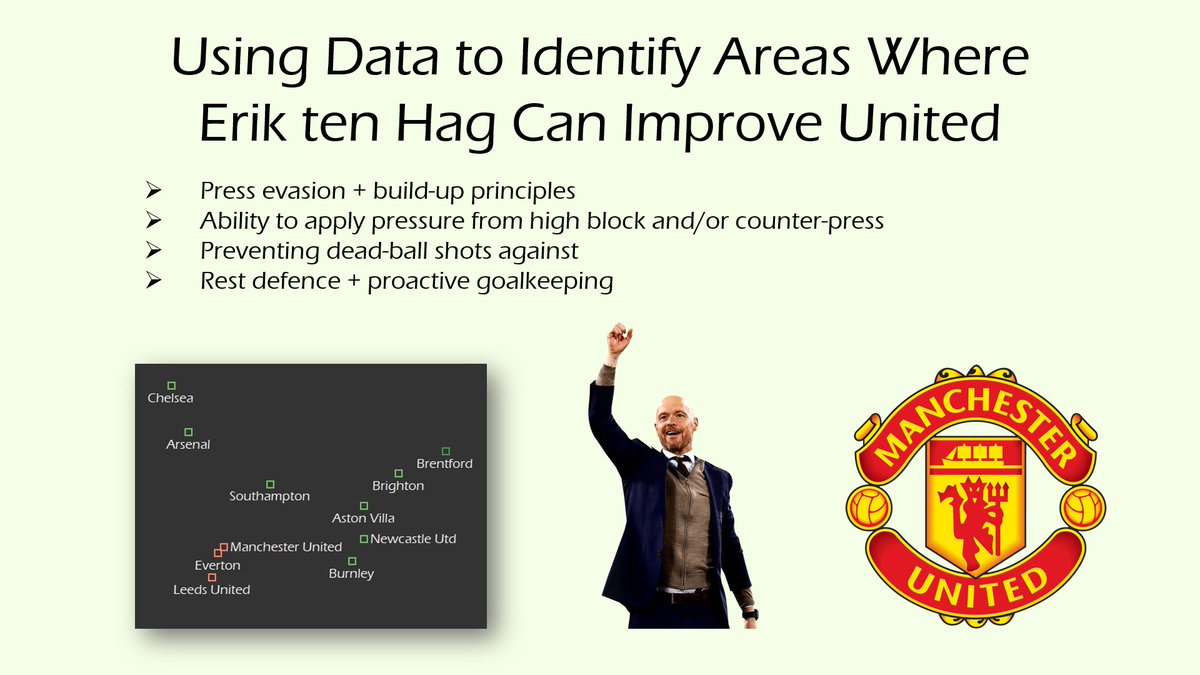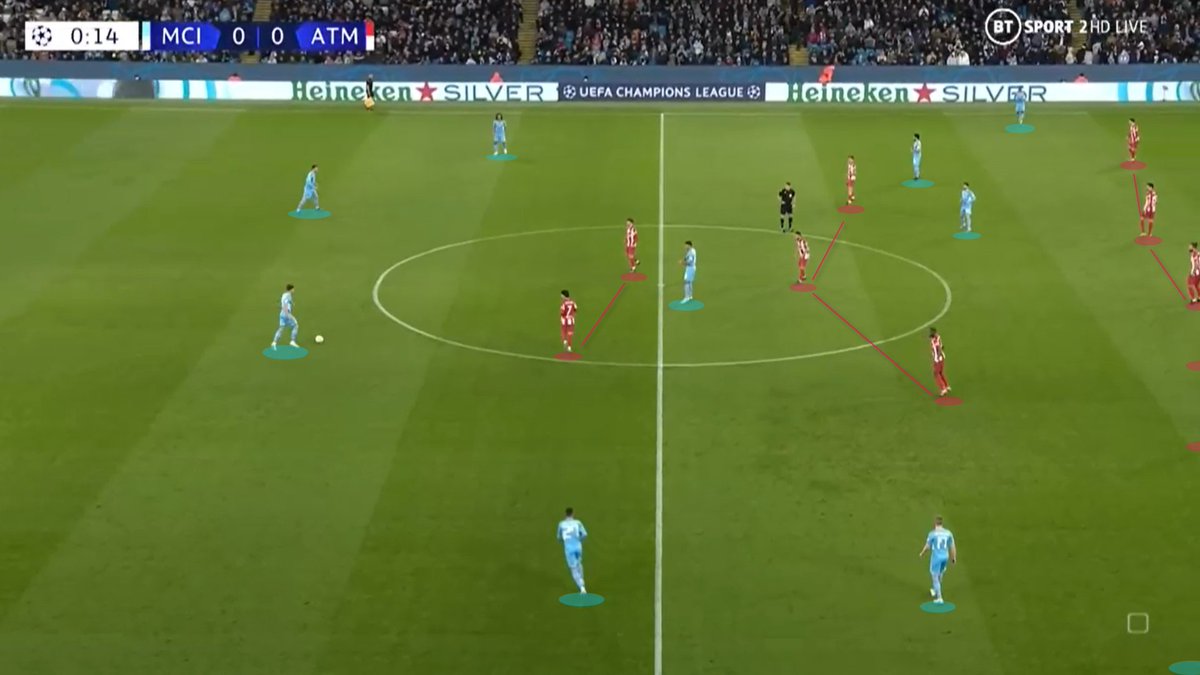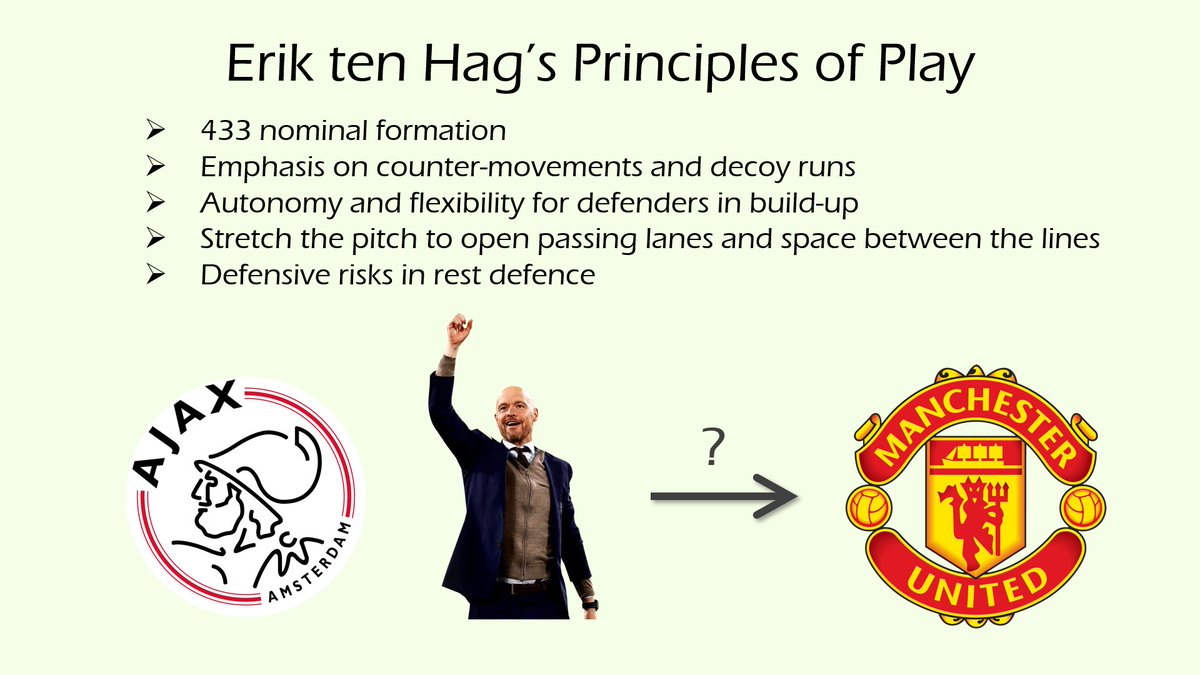Erik Ten Hag is revolutionising the way Manchester United play football. This isn’t without difficulty however – Ten Hag’s approach is risky and requires substantial change. This thread explores the topic of personnel and risk vs reward when considering ETH's principles. [Thread] 

There are three key facets to consider in this discussion:
- The risky nature of Ten Hag’s principles
- The quality and implementation of coaching
- The players: in terms of individual profiles and team make-up
- The risky nature of Ten Hag’s principles
- The quality and implementation of coaching
- The players: in terms of individual profiles and team make-up
Further, some parameters to consider when evaluating the relative success/failure of Ten Hag’s approach:
- Time it takes to implement principles
- Limiting factors (player quality & profiles, execution of principles, luck)
- What is to be considered a success
- Time it takes to implement principles
- Limiting factors (player quality & profiles, execution of principles, luck)
- What is to be considered a success
Pep Guardiola – a proven master in renovating squads to suit his possession-based style of play, makes it clear that he wants his players to receive the ball. He would rather they make a mistake than not show to receive:
https://twitter.com/i/status/1686669393504190464
There is so much to unearth here, and Guardiola's comments are so pertinent to the debates we are seeing surrounding Ten Hag’s style of play, and players such as De Gea (+ Onana) and Harry Maguire.
Key Point #1: “The thing I hate the most, is when you don’t want the ball” - Pep.
Guardiola is saying that his players must all be comfortable on the ball, especially in tight and risky situations, such as build-up. This is integral to their style of play and is non-negotiable.
Guardiola is saying that his players must all be comfortable on the ball, especially in tight and risky situations, such as build-up. This is integral to their style of play and is non-negotiable.

Why this is important:
- If all players are confident on the ball, you can trust them. This allows the team to build play quickly and effectively, better breaking down defensive blocks
- The passer doesn’t need to worry about the receiver being a risk or a limitation on the ball
- If all players are confident on the ball, you can trust them. This allows the team to build play quickly and effectively, better breaking down defensive blocks
- The passer doesn’t need to worry about the receiver being a risk or a limitation on the ball
This feeds in to point #2: “[wanting the ball is] what you train every day for”
- The entire team is trained towards a specific set of principles or goals – i.e. positional build-up play
- Constantly moving and positioning to receive is non-negotiable for all players
- The entire team is trained towards a specific set of principles or goals – i.e. positional build-up play
- Constantly moving and positioning to receive is non-negotiable for all players
Not wanting the ball is as big of an issue as not tracking back, or not pressing intensely – it just isn’t seen as disobedient and is therefore under-criticised by viewers. Poor off the ball work is ‘lazy’, but hiding in possession isn’t as obvious – but is arguably worse.
If players in a team keep the ball well, the defensive phase can at times be less important, as the team generally defends for less time. This isn’t to say rest-defence, pressing, etc, aren’t important though – they often facilitate possession-based tactics.
Conversely, constantly losing the ball exacerbates any issues in defensive tactics, execution or individual limitations. Losing the ball comes just as much through players not wanting the ball – not moving to receive with conviction and confidence.
Coming full circle: receiving the ball with clarity requires specialised coaching and ideal player profiles.
Players wanting to receive helps the coach’s principles work, while the coach’s training helps players to receive well.
It's symbiotic. Non-performers get found out.
Players wanting to receive helps the coach’s principles work, while the coach’s training helps players to receive well.
It's symbiotic. Non-performers get found out.
If a team takes risks on the ball, so be it. It’s the manager’s prerogative to decide the risk vs rewards of their system. And that is worth consideration when it comes to Erik ten Hag. But personnel selection and squad development is a huge factor, and United are at this stage.
David De Gea simply lacked the requisite ball-playing skills, composure, and willingness to help Ten Hag implement his style of play. Conversely, Andre Onana doesn’t just meet the standards required on the ball, but exceeds them. He is an example of an optimal player profile.
To an extent, it matters less whether De Gea was a better shot-stopper (his recent numbers were poor anyway) – United should be conceding less high-quality shots due to controlling games with the ball better, forcing defences deeper, and losing the ball less in build-up.
Harry Maguire is another player under criticism. Comparing him to Lisandro Martinez is interesting – Maguire may have been seen as a better defender (certainly aerially), but Martinez helped facilitate the above-mentioned on-ball benefits. All facets of play affect each other.
Guardiola’s Key Point #3: “You have permission to make a mistake, to lose [the ball]”
- Losing the ball/making mistakes is fine – as long as you’re fully committed to the principles
- Looking to always play the ‘right way’ is more important than playing safe, in *this* system
- Losing the ball/making mistakes is fine – as long as you’re fully committed to the principles
- Looking to always play the ‘right way’ is more important than playing safe, in *this* system
Players who aren’t engaged fully with the coach’s principles are often likely to be far more of a net negative anyway – they’ll receive with worse body angles, or will make passes which don’t facilitate good build-up.
The consequence of a poor pass:
The consequence of a poor pass:
https://twitter.com/i/status/1649316595263471619
To revisit the three key facets outlined regarding Ten Hag’s principles and choices:
- Ten Hag’s style is risky: the rest defence is often exposed
- Players are expected to be fluid in movement and progress play seamlessly
- Ten Hag’s style is risky: the rest defence is often exposed
- Players are expected to be fluid in movement and progress play seamlessly

Martinez and Shaw are excellent examples of players who meet all of Ten Hag’s demands. They can do the above. It also means United’s rest defence is less exposed. Other players can exacerbate Ten Hag’s weaknesses in rest defence:
https://twitter.com/i/status/1685979930981441536
The risk vs reward of Ten Hag’s principles are largely predicated on the personnel involved.
With signings such as Martinez, Eriksen, et al last summer, and Onana, Mount, etc this summer, Ten Hag is reshaping the squad.
With signings such as Martinez, Eriksen, et al last summer, and Onana, Mount, etc this summer, Ten Hag is reshaping the squad.
With time, the squad will minimise risks and maximise the upside of Ten Hag’s principles. This takes time, and the coaching of existing players (and even new players takes time too). Ultimately, this is all a process, and progress is evident.
There’s no expectation (yet) for everything to be 100% perfect. As long as there is clarity from a tactical and individual standpoint, and progress continues to be made, I’m very happy. The football is great to watch, and will continue to win us more and more games.
A success in my opinion, would be a league title (or consistent and sustained title challenges). A serious European challenge would be nice too.
In terms of a time-scale, I would say this should begin to happen within the next two years. From there we take stock and re-evaluate.
In terms of a time-scale, I would say this should begin to happen within the next two years. From there we take stock and re-evaluate.
• • •
Missing some Tweet in this thread? You can try to
force a refresh

 Read on Twitter
Read on Twitter















